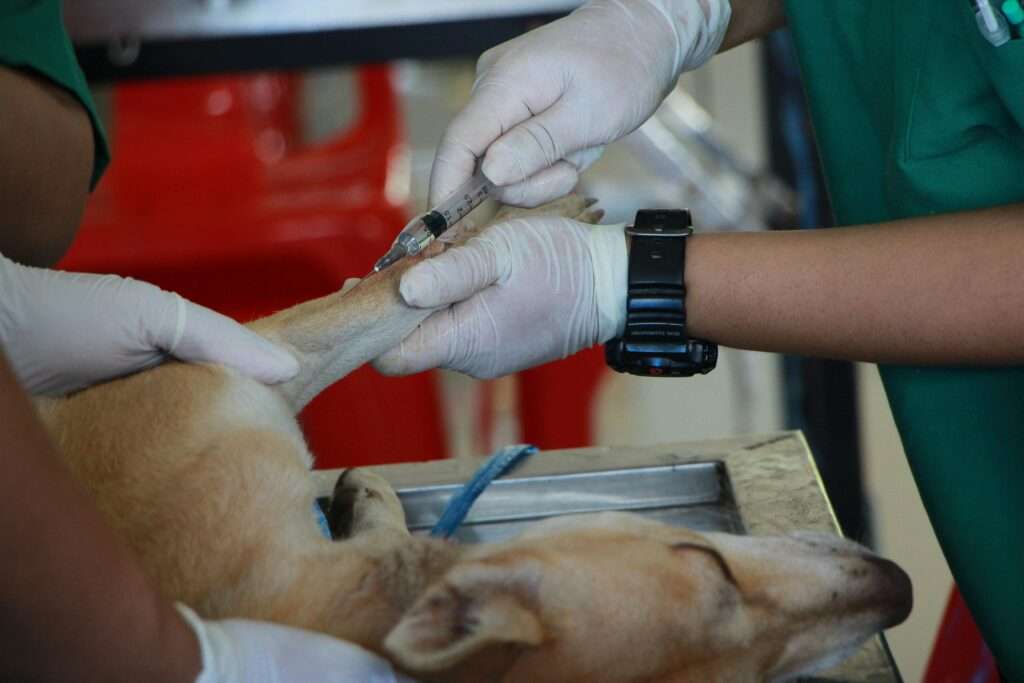You’ve probably heard of epilepsy or seizures in humans, but over 1% of canines also get epilepsy from an unexplained origin. Epilepsy is a condition in which the brain regularly works improperly, resulting in abrupt spikes in the brain’s electrical activity that causes twitching, convulsions, shaking, or spasms the dog is unable to stop or control.
According to Karen Munana, DVM, DACVIM (Neurology), an epilepsy researcher at North Carolina State University College of Veterinary Medicine, “idiopathic epilepsy is the most common chronic medical neurological condition in dogs.”
In several breeds where it is believed to have a genetic component, its prevalence is significantly higher.

What Is Canine Epilepsy?
Although the terms seizure and epilepsy are frequently used interchangeably, a seizure is the disorder’s outcome and can have multiple causes. There are three categories for the causes:
Toxins, metabolic diseases, high fevers, and other systemic illnesses affecting the entire body can cause reactive seizures.
Primary brain disorders such stroke, brain tumors, brain injury, or degeneration are the cause of structural seizures.
Seizures that are not caused by other factors are known as idiopathic epilepsy, which is further classified as epilepsy of unknown origin, presumed genetic, and proven genetic (breed-related).

Three groupings can also be used to classify the different kinds of seizures:
Previously known as grand mal seizures, generalized seizures affect the entire body, both sides of the brain, and typically result in unconsciousness. Stiffness, falling, chomping the jaws, shaking, trembling, vocalizing, urinating, and defecating are all possible.
Seizures can last many minutes, however they often endure between 30 and 90 seconds. A condition known as status epilepticus occurs when a seizure lasts longer or doesn’t stop.
Myoclonic seizures, which are generalized seizures in which the dog remains conscious, are typically brought on by environmental stimuli such as abrupt noises or flashing lights.
Previously known as partial or petit mal seizures, focal seizures only affect one side of the

How Is Epilepsy in Dogs Diagnosed?
Apart from epilepsy, other conditions like brain traumas, brain infections, high temperature, toxins, metabolic abnormalities, low blood sugar, or tumors can also induce seizures. Other causes can be ruled out with the aid of several tests. The age at which a dog has their first seizure, the likelihood of a seizure occurring, and other significant characteristics that may indicate epilepsy can all be determined using a standardized epilepsy questionnaire.
Seizures from other causes happen equally whether the dog is awake or asleep, but generalized epileptic seizures happen more frequently while the dog is sleeping or resting. The veterinarian may detect epilepsy in dogs of a certain breed if they are aware of whether epilepsy is more common in that breed.
Sometimes it’s difficult to distinguish between a seizure and a neurological condition in dogs. For instance, some dogs suffer from “idiopathic head bobbing” or “head tremors.” However, in contrast to a seizure, the dogs are typically able to divert their attention from the behavior and appear aware of their environment while engaging in it. Other dogs may experience tremors, trembling, and spasms due to intermittent neck pain.

Behavioral Cues of Epilepsy in Dogs
A seizure can be identified in part by the dog’s actions immediately before or after the seizure. The dog may appear dazed or disoriented following a broad seizure. These symptoms can occasionally be severe, including short-term blindness or hostility. Dogs may act strangely or appear nervous right before a seizure, which could be because they are having an aura like some people do.
A form of focused seizure could be the cause of the dog’s frequent snapping at phantom flies. “Fly biting syndrome, also known as fly catching syndrome, is a clinical phenomenon that has been demonstrated in dogs to be caused by one of three etiologies: gastrointestinal (GI) disease, obsessive compulsive behavior, or true epileptic seizures,” explains veterinary neurologist Yael Merbl, DVM, DECVN, of the Cornell University College of Veterinary Medicine.
To rule out potential reasons, other tests might be conducted. In addition to X-rays and blood and urine tests, more sophisticated procedures like computed tomography, magnetic resonance imaging, bile acid testing, or cerebrospinal fluid testing may be carried out. However, only a small percentage of these tests identify any cause, and some of them can be costly. Most dogs are simply classified with “idiopathic epilepsy,” which is epilepsy of unknown origin, because that reason is frequently incurable.

The following are the criteria for idiopathic epilepsy:
Age of first epileptic seizure: between six months and six years; history of two or more unprovoked epileptic seizures that occurred at least twenty-four hours apart
No other serious neurological issues
Test results for blood and urine showed no associated abnormalities.

What Is the Treatment for Epilepsy in Dogs?
Your dog does not necessarily need to start on anti-seizure medication just because they have had one seizure. Your dog might have a better life without medicine if seizures are minor or rare. Each situation is unique. However, generally speaking, the International Veterinary Epilepsy Task Force (IVETF) advises starting anti-seizure medicine for a dog who meets any of the following criteria:
- Two or more seizures within 6 months
- Prolonged seizures or cluster seizures
- Severe postictal signs
- Seizure severity or frequency is increasing
There are surprisingly few studies comparing the effectiveness of various medications in dogs. In the sole trial that examined the effectiveness of phenobarbital and potassium bromide when administered as separate medications, 85% of dogs treated with phenobarbital remained seizure-free for six months, while 52% of dogs treated with potassium bromide did the same. Potassium bromide is more frequently administered alongside phenobarbital. Levetiracetam, on the other hand, works well when used in combination with other medications but has a much lower success rate when taken alone.
The American College of Internal Veterinary Medicine offers recommendations for the use of the different medications, and the IVETF’s study offers a comprehensive comparison of ant-epileptic medications.

Do Non-Drug Treatments Work for Epilepsy in Dogs?
It’s normal to search for alternative therapy because anti-seizure medications can have negative side effects.
Certain forms of epilepsy in children have been successfully treated with cannabidiol (CBD), and at least one research has shown promising outcomes in canines.
Vagal nerve stimulation is authorized for humans and has been tested in dogs on a limited basis. It involves electrically stimulating the left cervical vagal nerve using a device that resembles a pacemaker. Although it was less beneficial in lowering spontaneously occurring seizures in dogs, it was proven to efficiently reduce experimentally produced seizures. However, as the study period progressed, there was a little decrease in seizure activity.
It has not been demonstrated that either homeopathic medications or acupuncture are beneficial.
It’s normal to search for alternative therapy because anti-seizure medications can have negative side effects.

Certain forms of epilepsy in children have been successfully treated with cannabidiol (CBD), and at least one research has shown promising outcomes in canines.
Vagal nerve stimulation is authorized for humans and has been tested in dogs on a limited basis. It involves electrically stimulating the left cervical vagal nerve using a device that resembles a pacemaker. Although it was less beneficial in lowering spontaneously occurring seizures in dogs, it was proven to efficiently reduce experimentally produced seizures. However, as the study period progressed, there was a little decrease in seizure activity.
It has not been demonstrated that either homeopathic medications or acupuncture are beneficial.
.
It’s normal to search for alternative therapy because anti-seizure medications can have negative side effects.
Certain forms of epilepsy in children have been successfully treated with cannabidiol (CBD), and at least one research has shown promising outcomes in canines.
Vagal nerve stimulation is authorized for humans and has been tested in dogs on a limited basis. It involves electrically stimulating the left cervical vagal nerve using a device that resembles a pacemaker. Although it was less beneficial in lowering spontaneously occurring seizures in dogs, it was proven to efficiently reduce experimentally produced seizures. However, as the study period progressed, there was a little decrease in seizure activity.
It has not been demonstrated that either homeopathic medications or acupuncture are beneficial.

It’s normal to search for alternative therapy because anti-seizure medications can have negative side effects.
Certain forms of epilepsy in children have been successfully treated with cannabidiol (CBD), and at least one research has shown promising outcomes in canines.
Vagal nerve stimulation is authorized for humans and has been tested in dogs on a limited basis. It involves electrically stimulating the left cervical vagal nerve using a device that resembles a pacemaker. Although it was less beneficial in lowering spontaneously occurring seizures in dogs, it was proven to efficiently reduce experimentally produced seizures. However, as the study period progressed, there was a little decrease in seizure activity.
It has not been demonstrated that either homeopathic medications or acupuncture are beneficial.
It’s normal to search for alternative therapy because anti-seizure medications can have negative side effects.
Certain forms of epilepsy in children have been successfully treated with cannabidiol (CBD), and at least one research has shown promising outcomes in canines.
Vagal nerve stimulation is authorized for humans and has been tested in dogs on a limited basis. It involves electrically stimulating the left cervical vagal nerve using a device that resembles a pacemaker. Although it was less beneficial in lowering spontaneously occurring seizures in dogs, it was proven to efficiently reduce experimentally produced seizures. However, as the study period progressed, there was a little decrease in seizure activity.
It has not been demonstrated that either homeopathic medications or acupuncture are beneficial.
Diet and Epilepsy in Dogs

However, another potentially significant area of nutrition is only now starting to receive attention. Munana says, “The microbiota-gut-brain axis, the intricate relationship between the nervous system and the gastrointestinal tract and the bacteria that live there, is probably what mediates dietary effects on seizure activity.” Numerous studies have been conducted on the microbiota-gut-brain axis, which is thought to be involved in the onset and progression of a number of neurological conditions in people, including epilepsy. It is well known that dietary changes can affect gut flora, which can then affect brain function. A recent study in mice clearly showed that the impact of the ketogenic diet is mediated by alterations in the gut microbiota and related neurotransmitter changes.
Funny Interactive Dog Plush Toy Jumping Moving Dog Toy
122 in stock
800m Digital Dog Training Collar Waterproof Rechargeable
122 in stock




